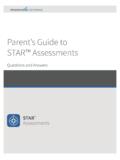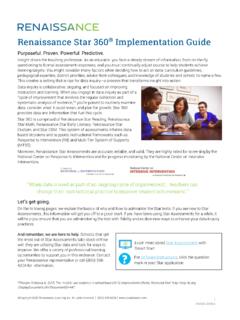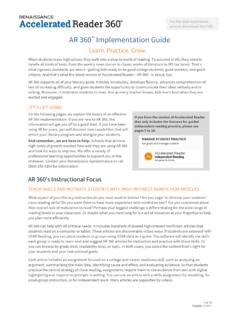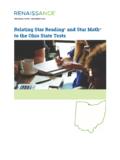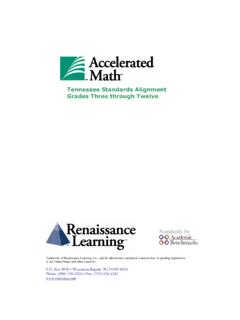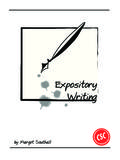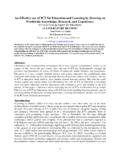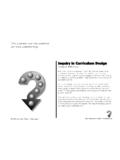Transcription of Effective Writing Instruction for All Students
1 1 Effective Writing Instruction for All StudentsWritten for Renaissance Learning by Steve Graham, Vanderbilt UniversityAdvanced Technology for Data-Driven Schools, NEO, Renaissance Learning, and the Renaissance Learning logo, are trademarks of Renaissance Learning, Inc., and its subsidiaries, registered, common law, or pending registration in the United States and other countries. 2008 by Renaissance Learning, Inc. All rights reserved. Printed in the United States of publication is protected by and international copyright laws. It is unlawful to duplicate or reproduce any copyrighted material without authorization from the copyright holder. For more information, contact:RENAISSANCE Box 8036 Wisconsin Rapids, WI 54495-8036(800) ..1 How Did We Get Into This Situation? ..1 How Do We Turn This Situation Around? ..1 What Are Effective Writing Practices?
2 2 Seven Recommendations for Teaching Writing ..3 Conclusion ..8 References ..10ii1 IntroductionImagine the public s reaction to these newspaper headlines:Almost 60% of Children Cannot Read Classroom Material50% of High School Graduates Not Prepared for College-Level ReadingReading Remediation Costs Businesses $ Billion a Year Parents, grandparents, business leaders, college presidents, and politicians would be incensed, demanding immediate action to rectify this alarming situation. Well, if we substitute the word write for read and Writing for reading this accurately represents the state of affairs for Writing in American society. It is time to take action. All Students need to learn to write effectively now. Why is this so important? Youngsters who do not learn to write well are at a considerable disadvantage. At school, they earn lower grades, especially in classes where written tests and reports are the primary means for assessing Students progress.
3 They are less likely than their more skilled classmates to use Writing to support and extend what they are learning in content classes. There is considerable evidence that Writing about content in science, social studies, and other content areas enhances how much Students learn (Bangert-Drowns, Hurley, & Wilkinson, 2004; Graham & Perin, 2007a). The opportunity to attend college is reduced too, as Writing is now used to evaluate applicants qualifications. Struggling writers also face considerable barriers in the real world. At work, Writing is a gateway for employment and promotion, especially in salaried positions (National Commission on Writing , 2004, 2005). Employees in business as well as government must be able to create clearly written documents, memoranda, technical reports, and electronic messages. Moreover, participation in civic life and the community at large has increasingly required the ability to write, especially as the use of email and text messaging has become so Did We Get Into This Situation?
4 Despite its importance, Writing does not receive enough attention in contemporary schools. My colleagues and I recently asked a random sample of high school teachers from across the United States to tell us about Writing Instruction in their classrooms (Kiuhara, Graham, & Hawkin, 2009). The most common Writing activities that their Students engaged in were Writing short answer responses to homework, responding to material read, completing worksheets, summarizing material read, Writing journal entries, and making lists. Together, these activities involved little extended analysis, interpretation, or Writing . In fact, one half of the most common assignments were basically Writing without composing (short answers, worksheets, and lists).Many teachers told us that they were not adequately prepared to teach Writing . Almost one half of them indicated that they had received minimal to no preparation to teach Writing .
5 This included the preparation they received at college, from their school district, and through their own efforts. Such preparation is extremely important, as we found that those who were better prepared were more likely to use Writing practices with a proven record of success and to make needed instructional adjustments for struggling writers. How Do We Turn This Situation Around?Somerset Maugham, the renowned novelist, once joked, There are three rules for Writing a novel. Unfortunately no one knows what they are. Maugham s jest implies that there is little certainty about how 2to teach Writing . While we may not know a lot about how to turn a good writer into a great novelist, we do know how to help developing writers become competent writers. An important step in turning around the current situation, then, is to make sure that all Students are taught how to write using Effective practices.
6 Writing is a complex skill. It requires considerable effort and time to master. While a single, Effective teacher can have a strong impact on a child s Writing development, the Herculean efforts of a few are no match for the sustained and concerted efforts of an entire organization. If a single teacher can make a difference, imagine what happens when Students are taught to write well beginning in first grade and all the way through high is especially important that Students get off to a good start in Writing . Waiting until later grades to address literacy problems that have their origins in the primary grades is not particularly successful (Slavin, Madden, & Karweit, 1989). As Students move toward the middle school grades, the teaching of Writing becomes more complex, as it no longer revolves around a single teacher at each grade level.
7 Writing and Writing Instruction become a shared responsibility across disciplines. English, science, social studies, and other content teachers must all devote significant attention to the teaching of Writing , if they expect Students to learn how to write effectively within their discipline. What Are Effective Writing Practices? Effective Writing practices have a proven record of success. In other words, they have been shown to be successful in enhancing Students Writing on multiple occasions. Primary sources for such practices are scientific studies examining the effectiveness of specific teaching techniques. They provide a trustworthy approach for identifying an Effective practice, as such investigations provide direct evidence both that the intervention works and of how much confidence can be placed in its effect. To provide recommendations for teaching Writing , I draw upon several recent reviews of the scientific Writing intervention literature (Graham, 2010; Graham & Perin, 2007a; Rogers & Graham, 2008) and present only those practices that have been validated in four or more useful method for identifying Effective Writing practices is to identify recurring patterns in the Instruction of teachers and schools that produce exceptional literacy achievement.
8 It is reasonable to assume that practices that are idiosyncratic to a specific teacher or school are potentially less important than those that are employed across all or most studies of such teachers and schools. Graham and Perin (2007b) identified Writing practices that were used in most studies examining exceptional teachers and schools, and I include those findings as well. Writing practices are likely to be even more Effective if they are embedded within a framework of what we know about how youngsters move from initial acclimation ( , novice writer) to competence ( , skilled writer). According to Alexander (1997) and Graham (2006), the road from novice to competent writer is paved by changes in Students Writing knowledge, motivation for Writing , strategic Writing behaviors, and basic Writing skills. Using this framework, along with the available scientific evidence on Effective Writing practices, I offer seven recommendations for teaching Writing that apply across grade levels.
9 Interspersed throughout these recommendations are 27 evidence-based practices numbered in parentheses, along with the academic source for each, so that interested readers can examine the evidence in more detail if so desired. Seven Recommendations for Teaching Writing1. Dedicate time to Writing , with Writing occurring across the curriculum, and involve Students in various forms of Writing over Increase Students knowledge about Foster Students interest, enjoyment, and motivation to write. 4. Help Students become strategic Teach basic Writing skills to mastery. 6. Take advantage of technological Writing Use assessment to gauge Students progress and Recommendations for Teaching WritingRecommendation 1. Dedicate time to Writing , with Writing occurring across the curriculum, and involve Students in various forms of Writing over Hazzlitt, the nineteenth-century novelist, observed that, The more a man writes, the more he can write.
10 This simple homily recognized that the opportunity to write is the foundation on which an Effective Writing program is built. In other words, Students are not likely to make much progress as writers if they are not given plenty of opportunities to apply and develop their craft. Teachers that achieve exceptional success in teaching Writing recognize the importance of frequent and sustained Writing (#1: Graham & Perin, 2007b). A good rule of thumb is that Students should spend at least one hour or more each day in the process of Writing planning, revising, authoring, or publishing text. This includes Writing projects that go beyond a single paragraph or day-to-day projects that may take weeks or even months to teachers further recognize the need for Students to learn to write for multiple purposes (#2: Graham & Perin, 2007b), including: Communicating with others ( , personal letters, business letters, notes, cards, email) Informing others ( , Writing reports; explaining how to do something.)

